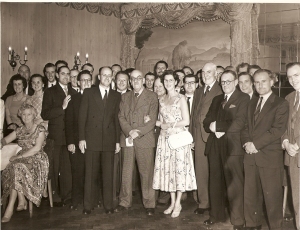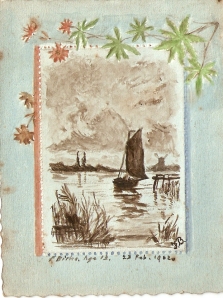I dedicate this page to my mother, born Audrey Elliott Birks in Derby, 21 June 1921, died in Belfast 22nd November, 2021. She loved Derby, her parents and her extended family. This history is part of her history.
My grandfather was born in Banbury 27 August 1888. His father was William Birks, a Unitarian Minister and his mother Jane Elliott Stevens (later Birks). He was one of the youngest of their nine surviving children. He married Florence Annie Paginton on 14 October 1916 in Derby. They had two children, a daughter born in 1921 and a son, Alan William in 1929. His daughter, Audrey Elliott Birks (later Crossland) died in Belfast in November 2021 in her 101st year. There are four granddaughters, all currently living in Ireland and one great grand-daughter.
Frank Elliott Birks with photographic equipment
At least part of his schooling was in Lee, South London, where his parents were living after his father’s career as a Unitarian Minister had foundered. His father had been a restless man and held a number of posts as a Minister, finally failing in Aberdeen, where the congregation did not take well to his preaching. The family returned to London in what appear to have been financially difficult circumstances with an additional burden of a sick daughter, Mary Elliott Birks.
 Frank jumping into Derby’s Bass Pool 1912
Frank jumping into Derby’s Bass Pool 1912
Frank started work in 1903 and was initially employed in the motor trade; in 1911 he is a store keeper in Ipswich for a motor and coach building company, boarding with a local family. From late-1911 until he retired in 1958 he worked in Rolls Royce, Derby as a cost accountant. In 1931 he is described as a ‘commercial clerk’ in the will of his Uncle, John Birks, a Unitarian Minister from who he received a small bequest. As a child staying with my grandparents I remember him cycling the short distance to Roll Royce, where he worked six days a week with Saturday as a half day. He continued to work until 70 so he could qualify for a full pension. He clearly had plans to write a book in his retirement and various notes and photographs for it still exist. Sadly, he died of heart disease in 1960 a couple of years after retirement .
 Leaving party August 1958. The woman on Frank’s arm is ‘Beryl’ a colleague who appears in other photographs.
Leaving party August 1958. The woman on Frank’s arm is ‘Beryl’ a colleague who appears in other photographs.
His real passions were his hobbies and interests. He loved photography and was president of the Derby Photographic Society 1931-2 and Honorary Secretary 1932-39. He was the author of History of the Derby Photographic Society, 1884-1934 and an album of selected photographs by members of the Society. He was a highly skilled and notable photographer. Like many photographers of his generation he carried out the whole process, from taking a photograph through developing, retouching and mounting it. He included his photographs in his family history work.
He was also a serious family and local historian, devoting much of his leisure time to researching and writing about the Birks of Ashover. Four notebooks with his extensive research still exist and are in the possession of his oldest grand-daughter. The notebooks also include a series of letters from one of his distant cousins, John Birks (1873-1947), a farmer in the village of Ashover. The two men had formed a friendship based on their mutual love of family and local history. It was a friendship spanning the war years, a period in which John Birks wife became ill and eventually died, and Frank’s daughter married and left Derby. The friendship ended when John died in a cycling accident in 1947. He was a keen rambler, spending his Sundays walking, photographing and visiting areas associated with his family roots in the Peak District. He never learned to drive and always traveled by public transport – with an almost mathematical understanding of train and bus timetables. He was a quiet, educated, well-read man with a deep love of learning; I can recall him on a Saturday afternoons in Derby Central Library working his way through Derbyshire history in pursuit of his ancestors. He was also an artistic man, this post card sized sketch was tucked into the back of an album; he was 13 when he produced it.
After his marriage he lived in Peartree Road, Derby; later he moved a short distance to Leacroft Road. His uncle John Birks lived in the area, as did two of his brothers, William and John. His wife’s parents, brother and sister-in-laws all lived in small railway terraces not far away. 16 Leacroft Road was a three-storey, nineteenth century red brick house with a small front garden and a long back garden, Frank and Florence lived there for the rest of their lives – Florence died there in 1972. He turned one of the attic rooms on the top floor into a dark room, where he developed his photographs. As a child I used to watch in fascination as the ghostly images emerged from the developing fluid.
His pocket diary for the last year of his life is in the possession of his grand-daughter. It notes his trips into town, phone calls to his daughter in Belfast, visits from his son. The last entry is on 23rd December 1961; he died on Christmas Day.
There is a coda to this life. In a bundle of old photographs and papers I recently found two photographs, one with the name of the photographer ‘Barkshire Broths, Albert Road, Southsea‘ on it, of a young, pretty girl probably in early 20th century costume. On the reverse of one is written Daisy Shellshear, an early girl friend of Frank Elliott Birks. These two photographs had been kept and suggest an early, sentimental attachment.
There were two Shellshear sisters living in Portsmouth in 1901, Margaret A. Shellshear aged 17 and Katherine A. Shellshear aged 19. The nickname Daisy suggests the photograph is of Margaret. In September 1930 Daisy A. Shellshear married a man called Hubbard in Brentford, Middlesex. This is almost certainly the same woman marrying relatively late in life.
Frank’s siblings were Mary (May), Ernest, Hilda, Ethel, William, John, Beatrice and Gilbert. All survived into adulthood, although two, Mary and Ernest died relatively young. They remained a close, affectionate family and as adults spent holidays together in Diss in Norfolk bringing their partners and children with them.




